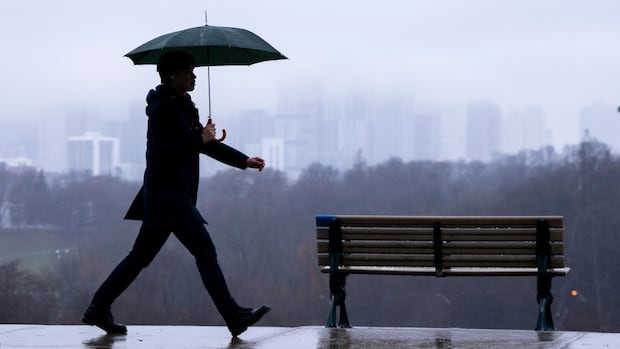She fell through the ground into an old septic tank. Experts say drought is destabilizing soil | CBC News
A northeastern B.C. woman is urging others to learn about what may be buried underneath the ground on their property, as persistent drought dries out the soil and causes the earth to shift.
· CBC News
·

Donna Kane was enjoying a quiet Friday, staining the deck on a windy April afternoon outside her farmhouse, when suddenly, while standing on the ground, the earth beneath her collapsed, and she fell into an open space below.
Kane, who has lived on the Rolla, B.C., property just north of Dawson Creek for nearly 18 years, fell into what she learned was an old septic tank, full of icy water that, fortunately, was no longer contaminated with waste.
But the water was over her head in the six-by-12-by-seven-foot tank. She couldn't pull herself out, so she had to figure out a way to keep her head above water so she wouldn't drown.

"I was able to sort of reach up and hang on to the top of the earth and scream my head off," she told CBC's Daybreak North host Carolina de Ryk.
Her husband, Wayne Sawchuk, was close by, just inside their house, but the sound of her screaming was muffled by the wind and the radio. From inside the tank, Kane reached out to grab onto a nearby chair leg, pulled it down and turned it into a makeshift monkey bar that she could hold onto until she was rescued.
Kane estimated she was in the hole for 20 minutes before her husband realized something was wrong and came outside to help her.
"After I got warmed up and cleaned off, we just realized that … for the last few years, we had noticed a little depression in the ground where that hole was. But we didn't think about it."
She's sharing her experience now to warn others that there may be something buried under their old homestead properties, and with the area currently at drought Level 4, they may end up in a similar situation if the parched ground gives way.
Luis Goncalves, a registered onsite wastewater practitioner, installer and planner based in West Kelowna, said it's unusual that a homeowner wouldn't know about a septic tank on their property because it should be disclosed during a land transfer or purchase.
Goncalves said it's important for people acquiring homes, especially in rural areas, to make sure they know what's under the ground before taking over a property. One place people can get that information, he added, is through their local health authority.
When septic systems are decommissioned, Goncalves said, the contents of a tank are emptied and the tank is filled in to avoid a situation like the one Kane found herself in.
The lifespan of septic systems can last anywhere from 20 to 40 years, he said, depending on soil permeability.

The soil in Kane's community is usually moist clay. But now, it's bone dry, she said. After multiple years of drought, she worries the ground has no moisture left, making it unstable.
"The clay always holds together really well. But now it's like popcorn," she said.
Soil scientist Diogo Spinola, an assistant professor at the University of Northern British Columbia, said clay soil is made up of extremely tiny particles — a grain of sand can be hundreds to 1,000 times larger than clay particles.
The small size of clay helps the soil to retain water, making it sensitive to drying and wetting, he added.
"The impact of drought on clay soils can be quite dramatic," Spinola said. "During dry periods, they shrink and crack visibly at the surface. This is the classic image of [the] drought effect [on] clay soils. The soils become very hard and dense, which can damage infrastructure like roads, building foundations and underground pipes."

Kane said while she was hanging in the septic tank, she took notice of the earth around her: it was dry, she said, and she could see each pebble and "distinction" in the soil.
Ministry of Agriculture soil specialist Dieter Geesing said when clay soils dry out, they shrink and can develop deep cracks that can disrupt soil structures. Repeated cycles of drying and moisture can lead to crumbling and long-term structural damage, he added.
It's been over a month since Kane fell through the ground. She and her husband have filled the tank in with rocks and dirt, and learned there are some old vehicles buried elsewhere in the yard.
She said she still feels a little startled when she walks on uneven ground or steps on a wobbly stair.
"I'm a little jittery, still. I know how lucky I was," Kane said. "Had Wayne not been here, I wouldn't have survived. And it could have been a child or someone who was unable to hang on for as long as I was able to."
Courtney Dickson is an award-winning journalist based in Vancouver, B.C.










